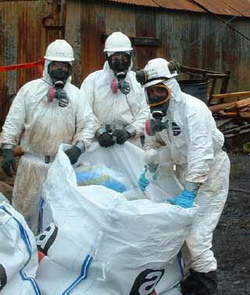The removal of asbestos is surely an expensive project that needs to be handled with care, preferably by professionals who have experience in the area. It is recommended that you are fully aware of the meaning of asbestos and the consequences of a failed removal. Many homeowners have attempted to remove asbestos on their own which is by all means doable; yet it's not suggested since it requires close attention to detail and full training on the topic.

Q: What is Asbestos?
A: Asbestos is the term that describes a group of natural minerals that is used in certain products related to building materials, vehicle brakes and insulation. There are two subgroups of asbestos known as serpentines, (being the most common one) and amphiboles. Asbestos is made of long fibers that can be separated. These fibers are also very strong and flexible and can be spun and woven. These fibers are also resistant to heat. Since the late 19th century they have been used for a number of industrial reasons.
Q: Is It Dangerous to Be Around Asbestos?
A: Once asbestos is broken down into pieces, yes, it is very dangerous to be around it. In the manufacturing and construction industry, the term "friable" refers to the crumbling down by hand of the asbestos material into dust. When this occurs, the asbestos becomes extremely hazardous for humans because it enters the lungs. Being exposed to asbestos has already caused thousands of deaths along the years; there are three known diseases caused by asbestos which are asbestosis, lung cancer, and mesothelioma.
Q: When and Why Was Asbestos First Used Commercially?
A: The US manufacturing and construction industry started its heavy asbestos use around 1858 and the first commercial mine was inaugurated in 1874 in Canada. Asbestos is a unique material that has many characteristics of extreme value for the industry. For example: the material doesn't burn and can't transmit heat efficiently therefore making it a great insulator against fire and in climate weather. It is also a great insulator against electricity and it is corrosion resistant. Asbestos is also strong and flexible making it the best candidate for the manufacturing of protective clothing. It can also be applied by spraying or painting it on a surface and can also be added to cement or concrete.
Q: What Health Conditions Does Exposure Cause and Are They Lethal?
A: The known diseases that derive from exposure are asbestosis, lung cancer, and mesothelioma; the three diseases can result with the death of the person. When serpentine asbestos is breathed in, the material is caught in the outer regions of the respiratory system. The smaller fibers are able to make their way in the smaller airways and are able to infiltrate inside the pleural lining and the chest wall. After this, they can damage the pleura's mesothelial cells which eventually will cause severe health conditions such as mesothelioma. Also, statistics have proven that people exposed to asbestos are seven times more likely to develop and die from lung cancer.
